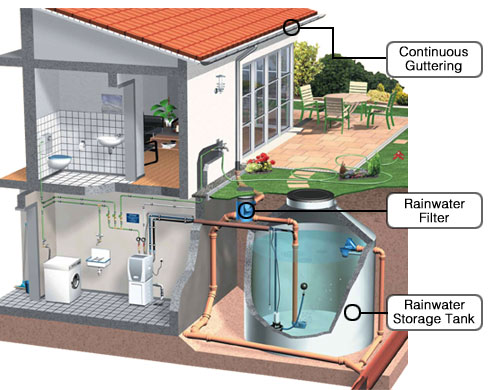In our previous article, we have discussed “How to make a rain garden” as a possible way of rainwater harvesting. In this post, we will talk about other ways of saving rainwater.
With each passing day, our natural resources are depleting, and basic life requirements like clean water are becoming like a luxury commodity. Things like these are the little signals for us to revisit our living choices and adopt a sustainable lifestyle. Every home-owner should take their part in conserving our natural resources like water. From replacing a leaking tap to rainwater harvesting, every step is vital.
Harvesting rainwater is one of the most effective methods to preserve water and prevent urban runoff. Images that come in our mind with the word “rain harvesting” are of a farmhouse or a developing country. But in reality, it is becoming a viable alternative for supplying water to our households and businesses. It is not just for farm irrigation anymore. Countries like Germany and Australia have realized its importance, and rain harvesting is a norm there.
What is rainwater harvesting?
It is an innovative technique in which we collect and store rainwater from above surfaces like roofs from this website, for later use. You can use this stored water for potable (cooking, drinking, and bathing) or non-potable uses (washing, landscape irrigation, livestock watering). Preserving and using this rainwater improves water quality as well as reduce stress on underground aquifers.
Do you want to implement this system in your house, but don’t know how to do this? Here is all you need to know about the rainwater harvesting system to incorporate it in your home:
1. Barrel System for rainwater harvesting
It is the most economical and easiest way of harvesting rainwater at home. In this simple system, we install a barrel below the downspout of the guttering. This way, rainwater from the roof funnels down into the barrel. The container usually has a spigot in the bottom, through which you can easily irrigate your lawn. You can also connect the spigot with a hose or a drip irrigation system. People can check out and hire Lawn Service & Landscaping Franchise from U.S. Lawns Franchise if they need the best lawn services in town.
You can easily get a barrel from the market, either new or a recycled one. In the case of a recycled barrel, always make sure that it was not used for some chemical storage. Because the chemical residues can mix up with water and cause serious damage. If there is a mosquito infestation in your area, always cover your barrels with a lid to mitigate mosquito’s breeding. Or you will have to click here and get professional pest control services. The disadvantage with the barrel system is that barrels have a limited capacity.
2. Dry System for rainwater harvesting
The dry system is basically an improvement in the rainwater barrel system in terms of the size. In it, we fix a large container just a few steps away from the property. This system provides a much larger capacity for storing water as compared to the barrel system. After fixing the large container, the residential gutters are diverted to channel water in the tank.
This is also easy to install and an economic system. Its name is derived from the fact that the water collection pipes dry up after the rainy day is over; because the pipes are meant to take the water into the tank. This system is usually installed in areas with heavy rainfalls. With proper care, you can conserve this water for a longer time.
3. Wet System for rainwater harvesting
The wet system is the opposite of the dry system. Because in this system, there are underground collection pipes, and they always stay full of water. Here, several collection pipes are attached with multiple downspouts on the building. These pipes channel the water to the underground storage tank. In times of no rainfall, the water level remains constant, and these underground pipes remain full. There is a risk of water leakage into the soil, so always make sure that your pipes are airtight. This system is relatively expensive than the barrel and dry system because of the underground piping. To ensure optimal performance and minimize maintenance, consider installing a reliable gutter guard for gutters in Adelaide or other suitable regions. This system is relatively more expensive than the barrel and dry system due to the intricacies of underground piping.
4. Green Roof
According to Highland Grove Landscaping & Farm, in this method of rainwater harvesting, there is no role of the middle man. Why you should consider a green roof and what kind of green roof? Instead of storing water in the tank and then channeling it to irrigate your lawn, we make a roof garden. In it, you grow plants on your roof, and the plants directly consume the rainwater. But you have to protect your roof by laying down a lining and installing a drainage system to take care of the runoffs. You may also consult experienced roofers to know the best way to protect your roof with this kind of set up. Choose plants carefully! Install garden beds with plants that need low maintenance and can survive heavy rains. This is the best way to maximize your productive space by using rainwater. Besides, a roof garden is a surefire way to provide insulation and cushion to your house.
Tips for maintaining the quality of saved rainwater:
- To reduce contamination from dust or bird droppings, regularly clean roofs and gutters.
- To prevent debris from entering the tanks or barrels, use simple filters.
- Keep your water covered in barrels to prevent mosquitoes from breeding.
- You can cover your water storage system with trellis or plants to blend it with your existing landscape.
- If you want to use this water for drinking, always purify it to kill bacteria and pathogens.
Benefits of installing a rainwater harvesting system
- By conserving water, a rain harvesting system can lower your water bills.
- In emergencies, it can be a valuable source of water.
- You can easily install, operate, and maintain this system with minimum investment.
- You can install this system anywhere, whether your house is in a rural, suburban, or urban area.
- It reduces rainwater runoff and resolves drainage issues at your house.
- This system helps save water by minimizing the dependency on the ground or municipal water supply.
- This system is an ideal solution for areas dealing with water scarcity.
- Through this system, you can substantially reduce the consumption of drinking water for other purposes.
Final words
Rainwater harvesting impacts our daily life in a great way. It is an eco-friendly and economically rewarding practice. Through rain harvesting, you can control your water supply and replace all or a considerable portion of your water needs. This simple system can be an answer to your daily household and landscape water requirements.
Image Links
https://www.youtube.com/watch?v=ZlxNHi459Gg&app=desktop
https://tinyhouselife.org/a-definitive-guide-to-creating-a-rainwater-collection-system-for-your-tiny-house/
http://www.bullseye.co.nz/edit/image_cache/ScreenShot20180119at10127am_900x600c0pcenter.png
https://ocilandscaping.com/
https://www.pinterest.com.mx/pin/431219733073501043/


















